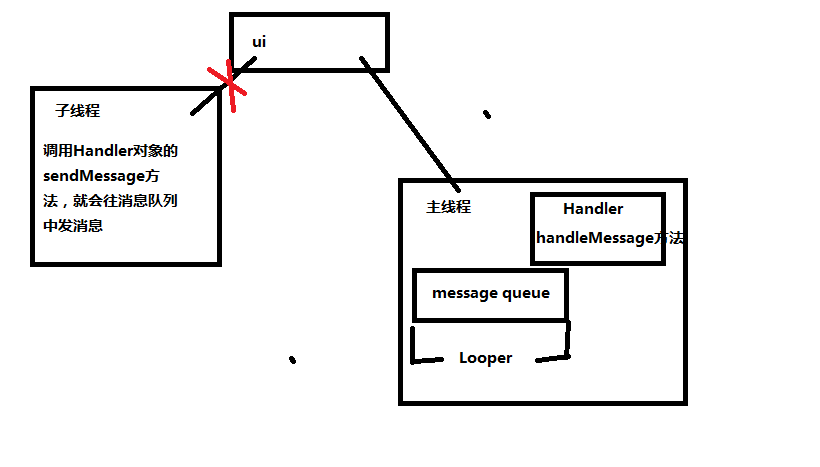Android应用开发基础之四:网络编程(一)
网络图片查看器
- 确定图片的网址
-
发送http请求
URL url = new URL(address); //获取连接对象,并没有建立连接 HttpURLConnection conn = (HttpURLConnection) url.openConnection(); //设置连接和读取超时 conn.setConnectTimeout(5000); conn.setReadTimeout(5000); //设置请求方法,注意必须大写 conn.setRequestMethod("GET"); //建立连接,发送get请求 //conn.connect(); //建立连接,然后获取响应吗,200说明请求成功 conn.getResponseCode(); -
服务器的图片是以流的形式返回给浏览器的
//拿到服务器返回的输入流 InputStream is = conn.getInputStream(); //把流里的数据读取出来,并构造成图片 Bitmap bm = BitmapFactory.decodeStream(is); -
把图片设置为ImageView的显示内容
ImageView iv = (ImageView) findViewById(R.id.iv); iv.setImageBitmap(bm); - 添加权限
- eg:
1 ublic class MainActivity extends Activity { 2 3 @Override 4 protected void onCreate(Bundle savedInstanceState) { 5 super.onCreate(savedInstanceState); 6 setContentView(R.layout.activity_main); 7 } 8 9 public void click(View v){ 10 //请求网址获取图片 11 //1.确定网址 12 String path = "http://10.16.17.138:8080/DT.png"; 13 try { 14 //2.获取url对象 15 URL url = new URL(path); 16 //3获取连接对象 17 HttpURLConnection conn = (HttpURLConnection) url.openConnection(); 18 //4.初始化连接对象 19 //设置请求的方法 20 conn.setRequestMethod("GET"); 21 //读取超时/连接超时 22 conn.setReadTimeout(5000); 23 conn.setConnectTimeout(5000); 24 25 //5.和服务器建立连接 26 conn.connect(); 27 28 if (conn.getResponseCode() == 200) { 29 //6.拿到服务器返回的流,客户端请求的数据,就保存在流中 30 InputStream is = conn.getInputStream(); 31 32 //7.从流里读取数据,构成一个图片对象 33 Bitmap bm = BitmapFactory.decodeStream(is); 34 ImageView iv = (ImageView) findViewById(R.id.iv); 35 36 //8.把图片设置进imageView 37 iv.setImageBitmap(bm); 38 } 39 else{ 40 Toast.makeText(this, "请求失败", 0).show(); 41 } 42 } catch (Exception e) { 43 e.printStackTrace(); 44 } 45 } 46 47 }
注:上面代码,只能2.3的虚拟机上运行,若在4.0上运行会报主线程网络异常:android.os.NetworkOnMainThreadException

阻塞一般为:
//5.和服务器建立连接
conn.connect();
和
//6.拿到服务器返回的流,客户端请求的数据,就保存在流中
InputStream is = conn.getInputStream();
主线程不能被阻塞
- 在Android中,主线程被阻塞会导致应用不能刷新ui界面,不能响应用户操作(home键是有效的),用户体验将非常差
- 主线程阻塞时间过长,系统会抛出ANR异常
- ANR:Application Not Response;应用无响应
- 任何耗时操作都不可以写在主线程
- 因为网络交互属于耗时操作,如果网速很慢,代码会阻塞,所以网络交互的代码不能运行在主线程
只有主线程能刷新ui
- 刷新ui的代码只能运行在主线程,运行在子线程是没有任何效果的
- 否则会提示出问题:

-
如果需要在子线程中刷新ui,使用消息队列机制
//消息队列 Handler handler = new Handler(){ //主线程中有一个消息轮询器looper,不断检测消息队列中是否有新消息,如果发现有新消息,自动调用此方法,注意此方法是在主线程中运行的 public void handleMessage(android.os.Message msg) { } };

消息队列
- Looper一旦发现Message Queue中有消息,就会把消息取出,然后把消息扔给Handler对象,Handler会调用自己的handleMessage方法来处理这条消息
- handleMessage方法运行在主线程
- 其实就是说只要消息队列中有消息,就会触发主线程去执行handleMessage方法
- 更直白的说,只要子线程往消息队列发消息,就会触发主线程去执行handleMessage方法
- 主线程创建时,消息队列和轮询器对象就会被创建,但是消息处理器对象,需要使用时,自行创建
-
在子线程中往消息队列里发消息
//创建消息对象 Message msg = new Message(); //消息的obj属性可以赋值任何对象,通过这个属性可以携带数据 msg.obj = bm; //what属性相当于一个标签,用于区分出不同的消息,从而运行不能的代码 msg.what = 1; //发送消息 handler.sendMessage(msg); -
通过switch语句区分不同的消息
public void handleMessage(android.os.Message msg) { switch (msg.what) { //如果是1,说明属于请求成功的消息 case 1: ImageView iv = (ImageView) findViewById(R.id.iv); Bitmap bm = (Bitmap) msg.obj; iv.setImageBitmap(bm); break; case 2: Toast.makeText(MainActivity.this, "请求失败", 0).show(); break; } }
加入缓存图片的功能
-
把服务器返回的流里的数据读取出来,然后通过文件输入流写至本地文件
//1.拿到服务器返回的输入流 InputStream is = conn.getInputStream(); //2.把流里的数据读取出来,并构造成图片 FileOutputStream fos = new FileOutputStream(file); byte[] b = new byte[1024]; int len = 0; while((len = is.read(b)) != -1){ fos.write(b, 0, len); } -
创建bitmap对象的代码改成
Bitmap bm = BitmapFactory.decodeFile(file.getAbsolutePath()); - 每次发送请求前检测一下在缓存中是否存在同名图片,如果存在,则读取缓存
获取开源代码的网站
- code.google.com
- github.com
- 在github搜索smart-image-view
- 下载开源项目smart-image-view
-
使用自定义组件时,标签名字要写包名:
<com.loopj.android.image.SmartImageView/> -
SmartImageView的使用:
SmartImageView siv = (SmartImageView) findViewById(R.id.siv); siv.setImageUrl("http://192.168.1.102:8080/dd.jpg");
Html源文件查看器
-
发送GET请求
URL url = new URL(path); //获取连接对象 HttpURLConnection conn = (HttpURLConnection) url.openConnection(); //设置连接属性 conn.setRequestMethod("GET"); conn.setConnectTimeout(5000); conn.setReadTimeout(5000); //建立连接,获取响应吗 if(conn.getResponseCode() == 200){ } -
获取服务器返回的流,从流中把html源码读取出来
byte[] b = new byte[1024]; int len = 0; ByteArrayOutputStream bos = new ByteArrayOutputStream(); while((len = is.read(b)) != -1){ //把读到的字节先写入字节数组输出流中存起来 bos.write(b, 0, len); } //把字节数组输出流中的内容转换成字符串 //默认使用utf-8 text = new String(bos.toByteArray());
乱码的处理
-
乱码的出现是因为服务器和客户端码表不一致导致
//手动指定码表 text = new String(bos.toByteArray(), "gb2312");
提交数据
GET方式提交数据
-
get方式提交的数据是直接拼接在url的末尾
final String path = "http://192.168.1.104/Web/servlet/CheckLogin?name=" + name + "&pass=" + pass; -
发送get请求,代码和之前一样
URL url = new URL(path); HttpURLConnection conn = (HttpURLConnection) url.openConnection(); conn.setRequestMethod("GET"); conn.setReadTimeout(5000); conn.setConnectTimeout(5000); if(conn.getResponseCode() == 200){ } -
浏览器在发送请求携带数据时会对数据进行URL编码,我们写代码时也需要为中文进行URL编码
String path = "http://192.168.1.104/Web/servlet/CheckLogin?name=" + URLEncoder.encode(name) + "&pass=" + pass;
POST方式提交数据
- post提交数据是用流写给服务器的
-
协议头中多了两个属性
- Content-Type: application/x-www-form-urlencoded,描述提交的数据的mimetype
-
Content-Length: 32,描述提交的数据的长度
//给请求头添加post多出来的两个属性 String data = "name=" + URLEncoder.encode(name) + "&pass=" + pass; conn.setRequestProperty("Content-Type", "application/x-www-form-urlencoded"); conn.setRequestProperty("Content-Length", data.length() + "");
-
设置允许打开post请求的流
conn.setDoOutput(true); -
获取连接对象的输出流,往流里写要提交给服务器的数据
OutputStream os = conn.getOutputStream(); os.write(data.getBytes());
心如猛虎,细嗅蔷薇。





